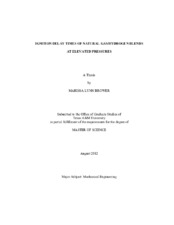| dc.description.abstract | Applications of natural gases that contain high levels of hydrogen have become a primary interest in the gas turbine market. For reheat gas turbines, understanding of the ignition delay times of high-hydrogen natural gases is important for two reasons. First, if the ignition delay time is too short, autoignition can occur in the mixer before the primary combustor. Second, the flame in the secondary burner is stabilized by the ignition delay time of the fuel. While the ignition delay times of hydrogen and of the individual hydrocarbons in natural gases can be considered well known, there have been few previous experimental studies into the effects of different levels of hydrogen on the ignition delay times of natural gases at gas turbine conditions.
In order to examine the effects of hydrogen content at gas turbine conditions, shock-tube experiments were performed on nine combinations of an L9 matrix. The L9 matrix was developed by varying four factors: natural gas higher-order hydrocarbon content of 0, 18.75, or 37.5%; hydrogen content of the total fuel mixture of 30, 60, or 80%; equivalence ratios of 0.3, 0.5, or 1; and pressures of 1, 10, or 30 atm. Temperatures ranged from 1092 K to 1722 K, and all mixtures were diluted in 90% Ar. Correlations for each combination were developed from the ignition delay times and, using these correlations, a factor sensitivity analysis was performed. It was found that hydrogen played the most significant role in ignition delay time. Pressure was almost as important as hydrogen content, especially as temperature increased. Equivalence ratio was slightly more important than hydrocarbon content of the natural gas, but both were less important than pressure or hydrogen content.
Further analysis was performed using ignition delay time calculations for the full matrix of combinations (27 combinations for each natural gas) using a detailed chemical kinetics mechanism. Using these calculations, separate L9 matrices were developed for each natural gas. Correlations from the full matrix and the L9 matrix for each natural gas were found to be almost identical in each case, verifying that a thoughtfully prepared L9 matrix can indeed capture the major effects of an extended matrix. | en |


